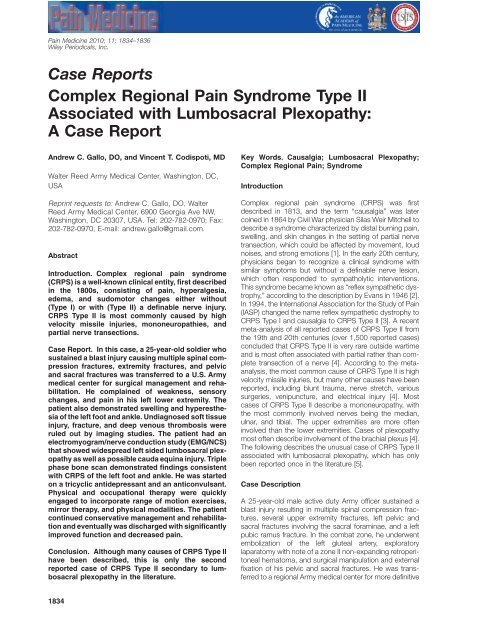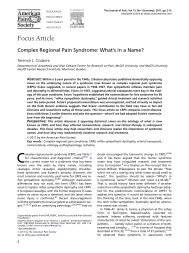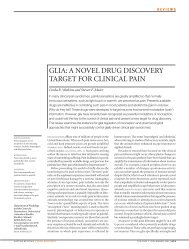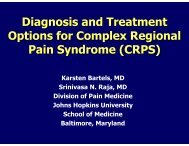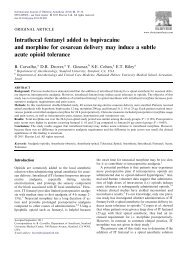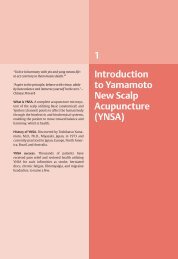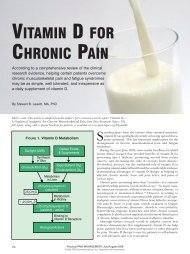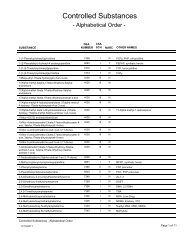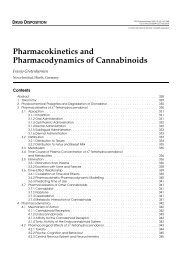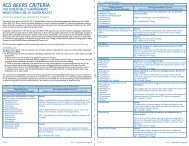Get PDF (123K) - Wiley Online Library
Get PDF (123K) - Wiley Online Library
Get PDF (123K) - Wiley Online Library
Create successful ePaper yourself
Turn your PDF publications into a flip-book with our unique Google optimized e-Paper software.
Pain Medicine 2010; 11: 1834–1836<br />
<strong>Wiley</strong> Periodicals, Inc.<br />
Case Reports<br />
Complex Regional Pain Syndrome Type II<br />
Associated with Lumbosacral Plexopathy:<br />
A Case Reportpme_996 1834..1836<br />
Andrew C. Gallo, DO, and Vincent T. Codispoti, MD<br />
Walter Reed Army Medical Center, Washington, DC,<br />
USA<br />
Reprint requests to: Andrew C. Gallo, DO, Walter<br />
Reed Army Medical Center, 6900 Georgia Ave NW,<br />
Washington, DC 20307, USA. Tel: 202-782-0970; Fax:<br />
202-782-0970; E-mail: andrew.gallo@gmail.com.<br />
Abstract<br />
Introduction. Complex regional pain syndrome<br />
(CRPS) is a well-known clinical entity, first described<br />
in the 1800s, consisting of pain, hyperalgesia,<br />
edema, and sudomotor changes either without<br />
(Type I) or with (Type II) a definable nerve injury.<br />
CRPS Type II is most commonly caused by high<br />
velocity missile injuries, mononeuropathies, and<br />
partial nerve transections.<br />
Case Report. In this case, a 25-year-old soldier who<br />
sustained a blast injury causing multiple spinal compression<br />
fractures, extremity fractures, and pelvic<br />
and sacral fractures was transferred to a U.S. Army<br />
medical center for surgical management and rehabilitation.<br />
He complained of weakness, sensory<br />
changes, and pain in his left lower extremity. The<br />
patient also demonstrated swelling and hyperesthesia<br />
of the left foot and ankle. Undiagnosed soft tissue<br />
injury, fracture, and deep venous thrombosis were<br />
ruled out by imaging studies. The patient had an<br />
electromyogram/nerve conduction study (EMG/NCS)<br />
that showed widespread left sided lumbosacral plexopathy<br />
as well as possible cauda equina injury. Triple<br />
phase bone scan demonstrated findings consistent<br />
with CRPS of the left foot and ankle. He was started<br />
on a tricyclic antidepressant and an anticonvulsant.<br />
Physical and occupational therapy were quickly<br />
engaged to incorporate range of motion exercises,<br />
mirror therapy, and physical modalities. The patient<br />
continued conservative management and rehabilitation<br />
and eventually was discharged with significantly<br />
improved function and decreased pain.<br />
Conclusion. Although many causes of CRPS Type II<br />
have been described, this is only the second<br />
reported case of CRPS Type II secondary to lumbosacral<br />
plexopathy in the literature.<br />
Key Words. Causalgia; Lumbosacral Plexopathy;<br />
Complex Regional Pain; Syndrome<br />
Introduction<br />
Complex regional pain syndrome (CRPS) was first<br />
described in 1813, and the term “causalgia” was later<br />
coined in 1864 by Civil War physician Silas Weir Mitchell to<br />
describe a syndrome characterized by distal burning pain,<br />
swelling, and skin changes in the setting of partial nerve<br />
transection, which could be affected by movement, loud<br />
noises, and strong emotions [1]. In the early 20th century,<br />
physicians began to recognize a clinical syndrome with<br />
similar symptoms but without a definable nerve lesion,<br />
which often responded to sympatholytic interventions.<br />
This syndrome became known as “reflex sympathetic dystrophy,”<br />
according to the description by Evans in 1946 [2].<br />
In 1994, the International Association for the Study of Pain<br />
(IASP) changed the name reflex sympathetic dystrophy to<br />
CRPS Type I and causalgia to CRPS Type II [3]. A recent<br />
meta-analysis of all reported cases of CRPS Type II from<br />
the 19th and 20th centuries (over 1,500 reported cases)<br />
concluded that CRPS Type II is very rare outside wartime<br />
and is most often associated with partial rather than complete<br />
transection of a nerve [4]. According to the metaanalysis,<br />
the most common cause of CRPS Type II is high<br />
velocity missile injuries, but many other causes have been<br />
reported, including blunt trauma, nerve stretch, various<br />
surgeries, venipuncture, and electrical injury [4]. Most<br />
cases of CRPS Type II describe a mononeuropathy, with<br />
the most commonly involved nerves being the median,<br />
ulnar, and tibial. The upper extremities are more often<br />
involved than the lower extremities. Cases of plexopathy<br />
most often describe involvement of the brachial plexus [4].<br />
The following describes the unusual case of CRPS Type II<br />
associated with lumbosacral plexopathy, which has only<br />
been reported once in the literature [5].<br />
Case Description<br />
A 25-year-old male active duty Army officer sustained a<br />
blast injury resulting in multiple spinal compression fractures,<br />
several upper extremity fractures, left pelvic and<br />
sacral fractures involving the sacral foraminae, and a left<br />
pubic ramus fracture. In the combat zone, he underwent<br />
embolization of the left gluteal artery, exploratory<br />
laparatomy with note of a zone II non-expanding retroperitoneal<br />
hematoma, and surgical manipulation and external<br />
fixation of his pelvic and sacral fractures. He was transferred<br />
to a regional Army medical center for more definitive<br />
1834
Complex Regional Pain Syndrome<br />
treatment of his orthopedic injuries and eventually to a<br />
U.S. Army medical center for inpatient rehabilitation. He<br />
screened positive for mild traumatic brain injury based on<br />
loss of consciousness of less than one minute but did not<br />
display any signs or symptoms of traumatic brain injury or<br />
post-traumatic stress disorder throughout his hospital<br />
stay. Approximately 1 month after his initial injury, the<br />
physical examination was significant for decreased sensation<br />
to light touch and pinprick over the left scrotum and<br />
penis, lateral thigh, posterior thigh, lateral calf, lateral foot,<br />
and hyperesthesia of the dorsum and sole of his left foot.<br />
The patient had weakness of left ankle dorsiflexors, toe<br />
extensors, and plantarflexors. The patient also had swelling<br />
of the left foot and ankle but no point tenderness. Skin<br />
temperature and texture were equal bilaterally. The patient<br />
complained of a constant burning and throbbing sensation<br />
in the left foot and calf, worse at night and with<br />
dependent positioning.<br />
In addition to the opioids he was already receiving, he was<br />
started on gabapentin with partial relief of his symptoms.<br />
In order to rule out previously undetected fracture, plain<br />
X-rays were obtained of the left hip, femur, tibia and fibula,<br />
ankle, and foot. No fractures or abnormalities were visualized.<br />
Venous ultrasonography of the left lower extremity<br />
was ordered, and it showed adequate venous flow and no<br />
evidence of deep venous thrombosis (DVT).<br />
An EMG/NCS of the lower extremities was performed in<br />
order to fully document the extent and location of his<br />
neurologic injury. The results indicated widespread<br />
involvement of the left lumbosascral plexus, including the<br />
femoral nerve, sciatic nerve, pudendal nerve, and gluteal<br />
nerves. Additionally, there were abnormalities in the<br />
lumbar paraspinals indicating possible involvement at the<br />
level of the nerve root or cauda equina.<br />
The patient continued to describe burning and throbbing<br />
pain in the left foot and ankle, variable swelling, and hypersensitivity<br />
to touch. He was started on nortriptyline, and a<br />
triple phase bone scan was ordered. The images showed<br />
asymmetric increased uptake in the left ankle and foot<br />
during blood flow and pool images, with particular note of<br />
uptake within periarticular structures. These scintigraphic<br />
findings were consistent with CRPS of the left ankle and<br />
foot. The patient was taken off gabapentin and started<br />
on pregabalin, which was rapidly titrated to effect and<br />
resulted in further improvement of his symptoms. Physical<br />
therapy was quickly engaged to incorporate range of<br />
motion exercises, contrast baths, mirror therapy, and<br />
desensitization techniques into his treatment plan. The<br />
patient was subsequently transferred to a VA polytrauma<br />
rehabilitation center where he continued aggressive physical<br />
therapy and medical management. He was transferred<br />
on the following medications with approximately 50%<br />
improvement of his symptoms: enoxaparin 30 mg twice<br />
daily, docusate/senokot, polyethylene glycol, lidocaine 5%<br />
patch to left foot 12 hours per day, clonazepam 0.5 mg<br />
three times daily as needed, pregabalin 100 mg three<br />
times daily, morphine sulfate immediate release 45 mg<br />
every four hours as needed, morphine sulfate sustained<br />
release 45 mg three times daily, and nortriptyline 25 mg at<br />
bedtime.<br />
His pelvic external fixation device was removed, and the<br />
swelling of the left foot and ankle improved as he was able<br />
to bear weight and ambulate. MRI of the left foot and ankle<br />
was obtained, showing diffuse periarticular edema consistent<br />
with CRPS. There was no evidence of soft tissue<br />
injury. He was offered a lumbar sympathetic block but<br />
preferred to maximize conservative management.<br />
He is ambulating independently and continues to functionally<br />
improve as an outpatient.<br />
Discussion<br />
According to the IASP, the diagnosis of CRPS can be<br />
made if the following criteria are fulfilled: preceding<br />
noxious event without (CRPS Type I) or with (CRPS<br />
Type II) associated nerve injury; spontaneous pain or<br />
hyperalgesia/ hyperesthesia not limited to a single nerve<br />
territory and disproportionate to the inciting event; evidence<br />
at some time of edema, skin blood flow (temperature)<br />
or sudomotor abnormalities in the region of pain; and<br />
other diagnoses are excluded [3]. Because the IASP<br />
permits diagnosis based on patient report and considers<br />
pain/hyperalgesia, vasomotor abnormalities, and sudomotor<br />
abnormalities as equivalent diagnostic criteria, it<br />
has been suggested that their criteria may be adequately<br />
sensitive (rarely missing a diagnosis of CRPS) but not<br />
sufficiently specific, leading to potential false positives. A<br />
consensus group met in Budapest in 2003 to propose<br />
new diagnostic criteria for CRPS. According to the proposed<br />
criteria, the patient must report one symptom in 3<br />
out of 4 of the following: sensory (hyperesthesia/allodynia),<br />
vasomotor (temperature asymmetry, skin color changes),<br />
sudomotor (edema, sweating), and motor/trophic<br />
(decreased range of motion, weakness, skin changes) as<br />
well as the presence of two or more signs at the time of<br />
evaluation: sensory (hyperalgesia/allodynia), vasomotor<br />
(temperature asymmetry, skin changes), sudomotor<br />
(edema, sweating), motor/trophic (decreased range of<br />
motion, weakness, skin changes) [6].<br />
As unilateral leg swelling usually implies a local mechanical<br />
or inflammatory process, our differential diagnosis in<br />
this case included soft tissue or ligamentous injury of the<br />
foot/ankle, fracture, DVT, and venous or lymphatic insufficiency.<br />
Undiagnosed fracture, venous insufficiency, and<br />
DVT were excluded by plain X-rays and venous ultrasonography.<br />
MRI of the left foot and ankle ruled out soft<br />
tissue injury. With severe soft tissue injury, we would<br />
have expected a more immediate onset of symptoms,<br />
gradual improvement over time, and different pain<br />
descriptors than “burning” or “throbbing.” In fact, as<br />
burning is the most common pain descriptor reported in<br />
CRPS Type II, some authors have concluded that the<br />
diagnosis of CRPS Type II is unlikely if burning pain is<br />
not present [4,7]. Others have noted the primarily distal<br />
location of symptoms that was also demonstrated in our<br />
patient [1,8].<br />
1835
Gallo and Codispoti<br />
Like most medical conditions, early diagnosis and treatment<br />
is important in maximizing outcome. It is worth<br />
noting, however, that in complex polytrauma patients, distracting<br />
injuries can effectively delay the onset of symptoms<br />
[9]. Our patient had a multitude of orthopedic injuries<br />
and had been through a number of major surgeries including<br />
an urgent cholecystectomy. His left foot and ankle<br />
symptoms appeared later and could easily have been<br />
missed early in the hospital course because of his more<br />
critical surgical issues.<br />
There is currently a paucity of evidence supporting the use<br />
of medications to treat CRPS. Medications such as tricyclic<br />
antidepressants and anticonvulsants are commonly<br />
used because of their documented efficacy in other neuropathic<br />
pain syndromes. Gabapentin has shown promise<br />
in some randomized trials [10,11]. Although opioids were<br />
once thought to have no role in the treatment of neuropathic<br />
pain, more recent research has indicated otherwise.<br />
In our patient, the pain caused by his multiple injuries<br />
would have been difficult to manage without opioids. A<br />
recent study showed that, at least for diabetic neuropathy<br />
and post-herpetic neuralgia, the combination of gabapentin<br />
and morphine was more effective than either agent<br />
alone [12]. Another study indicated that opioids were successful<br />
at reducing neuropathic pain levels secondary to<br />
peripheral neuropathy, focal nerve injury, post-herpetic<br />
neuralgia, spinal cord injury, central post-stroke pain, and<br />
multiple sclerosis although the authors concluded that a<br />
high-dose therapy was more efficacious than low dose<br />
therapy [13]. Similar combinations have been used to treat<br />
neuropathic pain in military polytrauma patients with<br />
success. Medications are an important part of treatment;<br />
however, many experts advocate an interdisciplinary<br />
approach including PT, OT, and psychology services to<br />
achieve the best functional outcome [14].<br />
This case describes a cause of CRPS Type II that has very<br />
rarely been reported in the literature. Our patient was very<br />
complex with multiple orthopedic and neurologic injuries<br />
and had an unusual cause of a well known pain syndrome.<br />
Fortunately, we were able to make an early diagnosis and<br />
initiate treatment that resulted in significant improvement.<br />
We believe this case demonstrates three important principles.<br />
First, while CRPS Type II commonly occurs in the<br />
setting of mononeuropathy, it should probably be considered<br />
in neurologic injuries as varied as plexopathy, radiculopathy,<br />
and other lower motor neuron injuries. Second,<br />
early diagnosis and treatment of CRPS is crucial, before<br />
central pain sensitization occurs and function is lost.<br />
Finally, when managing polytrauma patients with complex<br />
injuries, secondary causes of pain can be easily overlooked<br />
or attributed to routine musculoskeletal pain.<br />
Nonetheless, it is important to fully evaluate and consider<br />
a broad differential diagnosis in each pain complaint.<br />
Conflict of Interest<br />
The authors received no grants or other forms of support<br />
in the writing of this case report.<br />
The authors have no financial disclosures or other relationships<br />
that may lead to a conflict of interest.<br />
References<br />
1 Mitchell SW, Morehouse GR, Keen WW. Gunshot<br />
wounds and injuries of the nerves. Philadelphia, PA: JB<br />
Lippincott & Co.; 1864.<br />
2 Evans J. Sympathectomy for reflex sympathetic dystrophy:<br />
Report of 29 cases. JAMA 1946;132:620–3.<br />
3 Merskey H, Bogduk N, eds. Classification of Chronic<br />
Pain: Description of Chronic Pain Syndromes and Definition<br />
of Pain Terms. Report by the International Association<br />
for the Study of Pain Task Force on Taxonomy,<br />
2nd edition. Seattle, WA: IASP Press; 1994.<br />
4 Hassantash SA, Afrakhteh M, Maier RV. Causalgia:<br />
A meta-analysis of the literature. Arch Surg 2003;<br />
138:1226–31.<br />
5 Yoon KJ, Kim JL. Clinical experience of a complex<br />
regional pain syndrome type II patient: A case report.<br />
Korean J Pain 1996;9:426–9.<br />
6 Harden RN, Bruehl S, Stanton-Hicks M, et al. Proposed<br />
new diagnostic criteria for complex regional<br />
pain syndrome. Pain Med 2007;8:326–31.<br />
7 Hassantash SA, Maier RV. Sympathectomy for causalgia:<br />
Experience with military injuries. J Trauma<br />
2000;49:266–71.<br />
8 Stengel M, Binder A, Baron R. Updates on the diagnosis<br />
and management of complex regional pain syndrome.<br />
Adv Pain Manage 2007;1:96–104.<br />
9 Haythornthwaite JA, Benrud-Larson LM. Psychological<br />
aspects of neuropathic pain. Clin J Pain 2000;<br />
16(Suppl 2):S101–5.<br />
10 Mellick GA, Mellick LB. Reflex sympathetic dystrophy<br />
treated with gabapentin. Arch Phys Med Rehabil<br />
1997;78:98–105.<br />
11 van de Vusse AC, Stomp-van den Berg SG, Kessels<br />
AH, et al. Randomized controlled trial of gabapentin in<br />
complex regional pain syndrome type I. BMC Neurol<br />
2004;4:13.<br />
12 Gilron I, Bailey JM, Tu D, et al. Morphine, gabapentin,<br />
or their combination for neuropathic pain. N Engl J<br />
Med 2005;352:1324–34.<br />
13 Rowbotham MC, Twilling L, Davies PS, et al. Oral<br />
opioid therapy for chronic peripheral and central neuropathic<br />
pain. N Engl J Med 2003;348:1223–32.<br />
14 Stanton-Hicks M, Burton AW, Bruehl SP, et al. An<br />
updated interdisciplinary clinical pathway for CRPS:<br />
Report of an expert panel. Pain Pract 2002;2(1):1–16.<br />
1836


